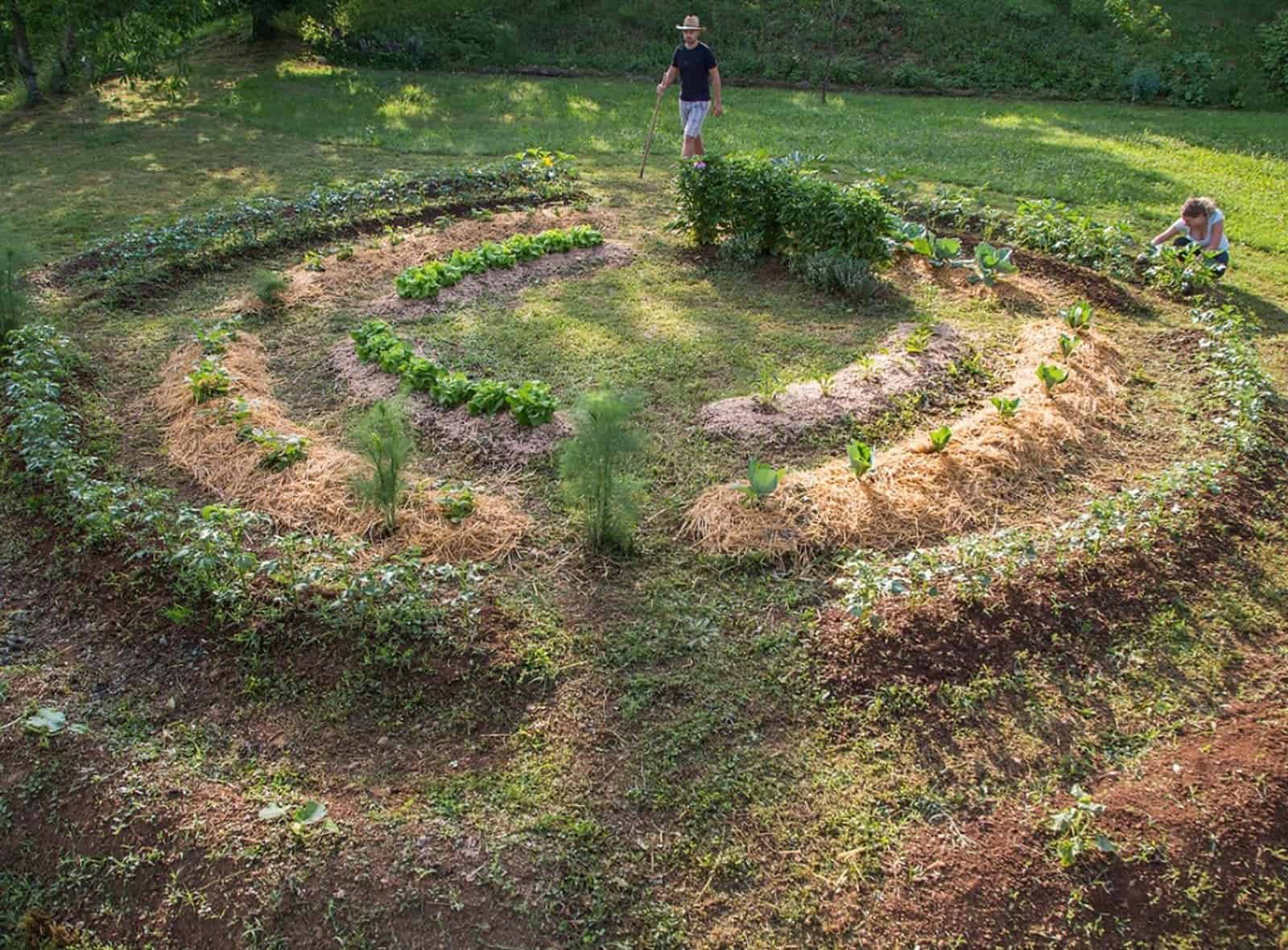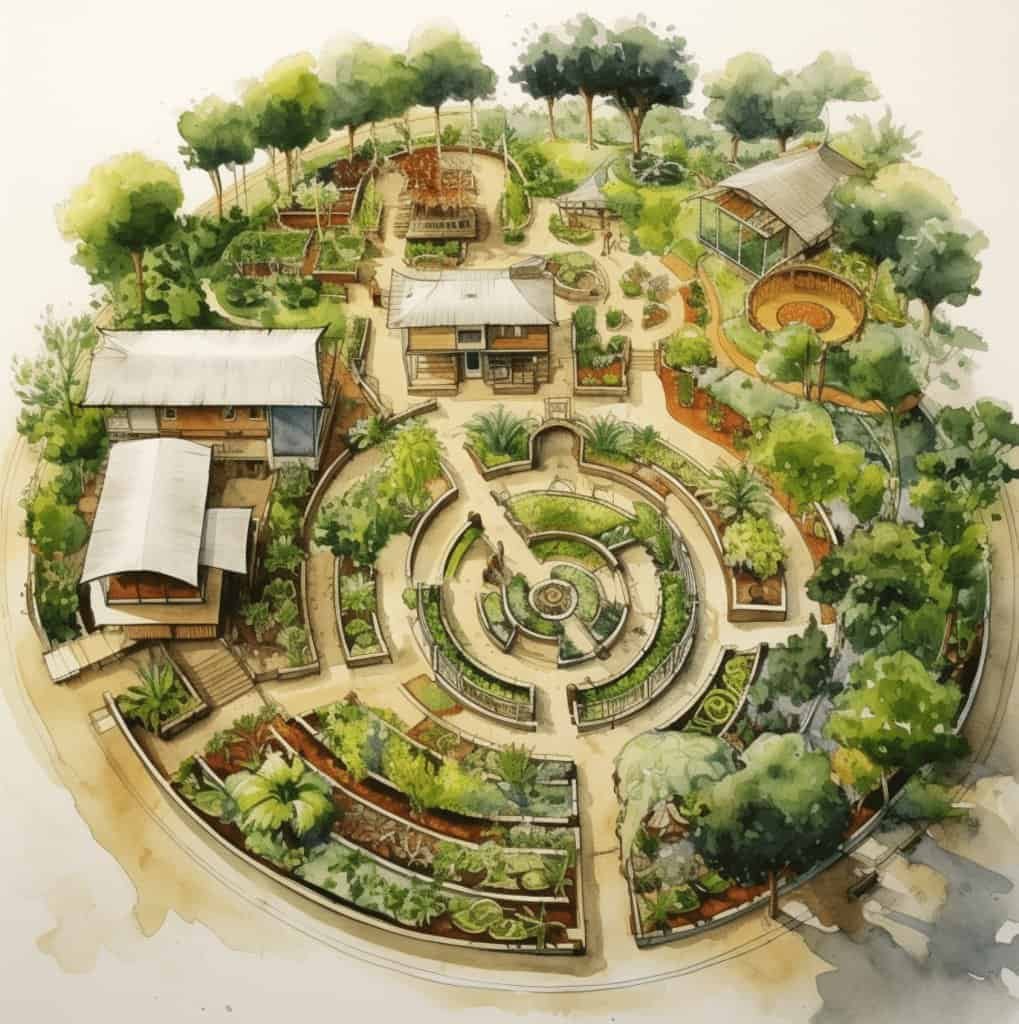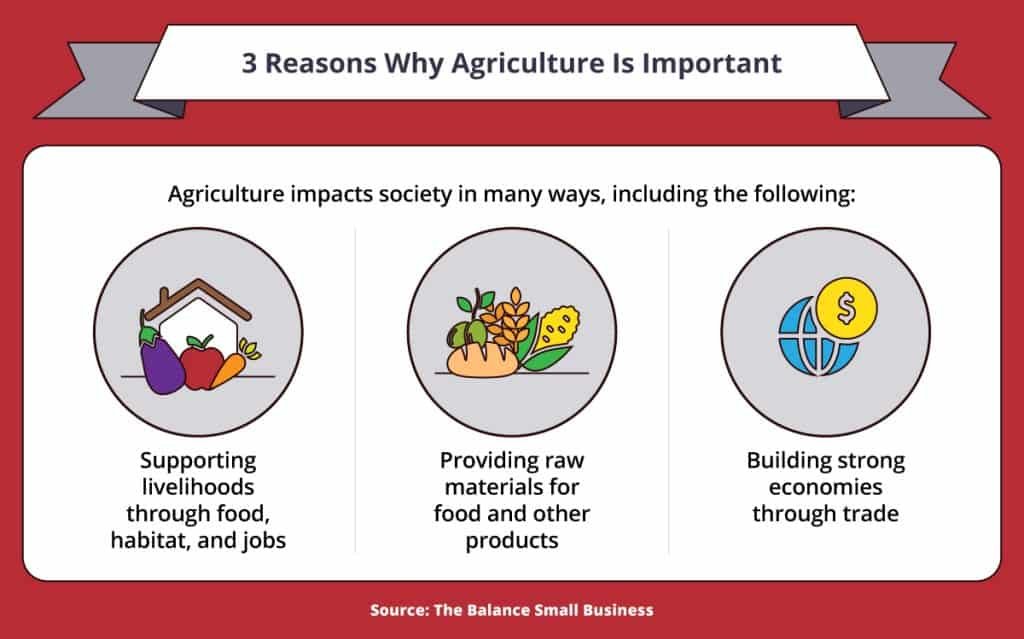Design a small-sized permaculture garden by integrating diverse plant species in raised beds, incorporating companion planting, installing a rainwater harvesting system, using compost bins for waste recycling, and creating habitat zones for beneficial wildlife.
The Art of Mini Permaculture: Designing a Small-Sized Garden for Maximum Impact
Mini permaculture is a sustainable gardening practice that focuses on maximizing the use of small spaces to create productive and diverse ecosystems. It is based on the principles of permaculture, which emphasizes working with nature to create self-sustaining and regenerative systems.
Mini permaculture is important because it allows individuals with limited space, such as urban dwellers or those living in apartments, to grow their own food and contribute to a more sustainable and resilient food system. By utilizing small spaces efficiently and incorporating permaculture principles, mini permaculture gardens can provide a variety of benefits, including increased access to fresh and nutritious produce, reduced environmental impact, and a deeper connection to the natural world.
In addition to providing a source of fresh food, mini permaculture gardens can also serve as a valuable educational tool, helping individuals learn about the importance of biodiversity, soil health, and sustainable living practices. By embracing mini permaculture, individuals can take an active role in promoting environmental stewardship and resilience in their communities, making a positive impact on the planet and future generations.
Assessing Your Space: Evaluating the Potential of Your Small-Sized Garden
Before embarking on a mini permaculture project, it is important to assess the potential of your small-sized garden. Start by evaluating the available space, taking note of any existing features such as sunlight exposure, soil quality, and potential obstacles. Consider the layout of the space and how it can be utilized to maximize productivity and diversity. Take into account any limitations, such as lack of direct sunlight or poor drainage, and brainstorm creative solutions to work around these challenges. By carefully assessing your space, you can develop a clear understanding of its potential and make informed decisions when designing and implementing your mini permaculture garden.
Once you have a good understanding of your space, consider the specific goals and priorities for your mini permaculture garden. Are you primarily interested in growing food, creating habitat for wildlife, or simply beautifying your surroundings? By identifying your goals, you can tailor your mini permaculture design to meet your specific needs and preferences. Additionally, consider the resources available to you, such as time, budget, and access to materials, and how these factors will influence the design and maintenance of your mini permaculture garden. By carefully assessing your space and setting clear goals, you can lay the foundation for a successful and fulfilling mini permaculture project.
Designing for Maximum Impact: Utilizing Vertical Space and Companion Planting
In small-sized gardens, maximizing space is essential for creating a productive and diverse mini permaculture system. One effective strategy for utilizing limited space is to incorporate vertical gardening techniques. Vertical gardening allows you to grow plants upwards, using trellises, arbors, or other structures to support climbing plants such as beans, cucumbers, and tomatoes. By taking advantage of vertical space, you can increase the overall productivity of your garden and create a visually appealing and dynamic growing environment. Additionally, vertical gardening can help to optimize sunlight exposure and airflow, promoting healthier plants and reducing the risk of disease.
Companion planting is another valuable design strategy for maximizing the impact of a mini permaculture garden. By planting compatible species together, you can create mutually beneficial relationships that support the health and productivity of your garden. For example, planting aromatic herbs such as basil and mint alongside vegetables can help to repel pests and attract beneficial insects, while interplanting nitrogen-fixing legumes with heavy-feeding crops can improve soil fertility and overall plant health. By carefully selecting plant combinations and considering their interactions, you can create a harmonious and resilient mini permaculture garden that thrives in a small space.
Choosing the Right Plants: Selecting Varieties that Thrive in Small Spaces
When planning a mini permaculture garden, it is important to choose plant varieties that are well-suited to small spaces and can thrive in the specific conditions of your garden. Look for compact or dwarf varieties of vegetables, fruits, and herbs that are well-suited to container gardening or small raised beds.
Consider the growth habits and space requirements of each plant, and select varieties that will not overcrowd or compete with one another. Additionally, prioritize plants that are well-adapted to the local climate and growing conditions, as they will be more likely to thrive and produce a bountiful harvest in your mini permaculture garden.
In addition to selecting plants based on their size and adaptability, consider incorporating a diverse range of species to promote resilience and biodiversity in your mini permaculture garden. Embrace a mix of edible and ornamental plants, as well as native and heirloom varieties, to create a dynamic and multifunctional growing environment.
By choosing a wide range of plants, you can attract beneficial insects, improve soil health, and create a visually appealing and diverse mini permaculture garden. Ultimately, selecting the right plants is essential for creating a thriving and resilient mini permaculture garden that maximizes the potential of a small space.
Here’s a table listing the right plants for a permaculture garden, categorized by their roles:
| Plant Type | Examples | Functions & Benefits |
|---|---|---|
| Nitrogen Fixers | Clover, Alfalfa, Peas, Beans | Enrich soil with nitrogen, improve fertility |
| Dynamic Accumulators | Comfrey, Dandelion, Yarrow | Mine nutrients from deep soil layers, improve soil health |
| Ground Covers | Creeping Thyme, Strawberries, Clover | Prevent soil erosion, retain moisture, suppress weeds |
| Pollinator Attractors | Lavender, Sunflowers, Echinacea | Attract pollinators, enhance biodiversity |
| Edible Perennials | Asparagus, Rhubarb, Artichokes | Provide continuous food supply with minimal maintenance |
| Fruit Trees | Apple, Pear, Plum | Produce fruit, provide shade, support ecosystem |
| Medicinal Herbs | Mint, Chamomile, Echinacea | Offer medicinal benefits, attract beneficial insects |
| Companion Plants | Basil (with Tomatoes), Marigolds | Improve growth and flavor of main crops, repel pests |
| Mulch Plants | Lemon Balm, Comfrey, Sweet Potato Vine | Produce organic mulch, improve soil health |
Water Management: Efficient Irrigation Systems for Mini Permaculture Gardens
Efficient water management is crucial for the success of a mini permaculture garden, especially in small-sized spaces where water resources may be limited. When designing a mini permaculture garden, consider implementing water-saving techniques such as drip irrigation, rainwater harvesting, and mulching to minimize water usage and promote healthy plant growth.
Drip irrigation systems deliver water directly to the root zone of plants, reducing evaporation and water waste compared to traditional overhead watering methods. By using drip irrigation, you can ensure that plants receive the water they need while conserving this precious resource.
Rainwater harvesting is another valuable water management strategy for mini permaculture gardens. By collecting and storing rainwater from rooftops or other surfaces, you can supplement your garden’s water supply and reduce reliance on municipal water sources.
Rainwater can be collected in barrels or cisterns and used to irrigate plants during dry periods, helping to maintain soil moisture and support healthy plant growth. Additionally, consider using mulch to conserve soil moisture and reduce the need for frequent watering.
Mulch helps to retain moisture in the soil, suppress weeds, and improve soil structure, contributing to overall water efficiency in a mini permaculture garden. By implementing efficient irrigation systems and water-saving techniques, you can promote the health and productivity of your mini permaculture garden while conserving water resources.
Soil Health: Building and Maintaining Fertile Soil in Small-Sized Gardens
Healthy soil is the foundation of a successful mini permaculture garden, providing essential nutrients and support for plant growth. When working with small-sized gardens, it is important to prioritize soil health and fertility to maximize the productivity and resilience of the growing environment.
Start by testing the soil in your garden to assess its pH, nutrient levels, and texture, and make any necessary amendments to improve soil quality. Incorporate organic matter such as compost, aged manure, or leaf mold to enrich the soil and promote beneficial microbial activity. By building and maintaining fertile soil, you can create a thriving and productive mini permaculture garden that supports healthy plant growth and abundant harvests.
In addition to enriching the soil with organic matter, consider implementing soil conservation practices to protect and improve soil health in a small-sized garden. Avoid compacting the soil by walking or working in the garden when it is wet, as this can disrupt soil structure and reduce aeration and water infiltration.
Use raised beds or containers to create well-drained growing areas and minimize soil disturbance. Additionally, practice crop rotation and intercropping to prevent nutrient depletion and promote balanced soil fertility. By prioritizing soil health and implementing conservation practices, you can create a resilient and productive mini permaculture garden that thrives in a small space.
Incorporating Permaculture Principles: Embracing Diversity and Sustainability in Design
Permaculture principles provide a valuable framework for designing and managing mini permaculture gardens, emphasizing diversity, sustainability, and resilience in the growing environment. When planning a mini permaculture garden, consider how you can incorporate these principles to create a productive and regenerative ecosystem.
Embrace diversity by incorporating a wide range of plant species, including edible and ornamental varieties, to promote ecological balance and resilience. By creating a diverse and multifunctional garden, you can attract beneficial insects, improve soil health, and create a visually appealing and dynamic growing environment.
Sustainability is another key principle of permaculture that can be applied to mini permaculture garden design. Consider how you can minimize waste, conserve resources, and promote self-sufficiency in your garden. Implement practices such as composting, rainwater harvesting, and natural pest control to reduce reliance on external inputs and create a more sustainable and resilient growing environment.
By embracing permaculture principles, you can create a mini permaculture garden that not only provides a source of fresh food but also contributes to the health of the surrounding ecosystem and promotes sustainable living practices.
Managing Pests and Diseases: Natural Solutions for Small-Sized Garden Challenges
Pests and diseases can pose significant challenges in small-sized gardens, but there are a variety of natural solutions that can help to manage these issues without the use of harmful chemicals. When designing a mini permaculture garden, consider implementing strategies such as companion planting, crop rotation, and biological pest control to minimize the impact of pests and diseases.
Companion planting involves interplanting species that repel pests or attract beneficial insects, helping to create a balanced and resilient growing environment.
For example, planting aromatic herbs such as basil and thyme alongside vegetables can help to deter pests and promote overall plant health.
Crop rotation is another valuable strategy for managing pests and diseases in a small-sized garden. By rotating crops from year to year, you can disrupt pest life cycles and reduce the buildup of soil-borne diseases, promoting healthier plants and higher yields.
Additionally, consider using biological pest control methods such as introducing beneficial insects or using natural predators to manage pest populations. By prioritizing natural solutions for pest and disease management, you can create a healthy and resilient mini permaculture garden that thrives in a small space.
Harvesting and Preserving: Maximizing Yields in a Limited Space
Maximizing yields is a key goal of mini permaculture gardening, and there are a variety of strategies that can help to make the most of a small-sized growing environment. When planning a mini permaculture garden, consider implementing techniques such as succession planting, intercropping, and season extension to extend the growing season and increase overall productivity.
Succession planting involves sowing new crops as soon as previous ones are harvested, allowing you to make the most of limited space and maximize yields throughout the growing season. Intercropping, or planting different crops together in the same area, can also help to maximize productivity and create a diverse and multifunctional growing environment.
Season extension techniques such as using row covers, cold frames, or hoop houses can help to prolong the growing season and allow for the cultivation of crops that may not otherwise thrive in a small space. By implementing these strategies, you can make the most of a limited growing area and increase the overall productivity and diversity of your mini permaculture garden.
Additionally, consider preserving the harvest through techniques such as canning, freezing, or drying to extend the enjoyment of homegrown produce throughout the year. By maximizing yields and preserving the harvest, you can make the most of a small-sized garden and enjoy the benefits of fresh and nutritious homegrown food.
Community and Education: Sharing the Benefits of Mini Permaculture with Others
Community and education are important aspects of mini permaculture gardening, providing opportunities to share the benefits of sustainable and regenerative gardening practices with others. Consider how you can engage with your local community to promote the principles of mini permaculture and inspire others to embrace sustainable living practices.
Host workshops, garden tours, or community events to share your knowledge and experience with mini permaculture gardening, and encourage others to get involved in creating their own productive and resilient growing environments.
In addition to engaging with the local community, consider how you can incorporate educational opportunities into your mini permaculture garden. Create signage or informational materials to explain the design and principles behind your garden, and consider hosting educational programs or demonstrations to teach others about sustainable gardening practices. By sharing the benefits of mini permaculture with others, you can inspire a deeper connection to the natural world and promote environmental stewardship in your community.
Ultimately, community and education are essential components of mini permaculture gardening, providing opportunities to share knowledge, build connections, and make a positive impact on the world around us.
Originally posted 2024-05-25 16:12:03.





